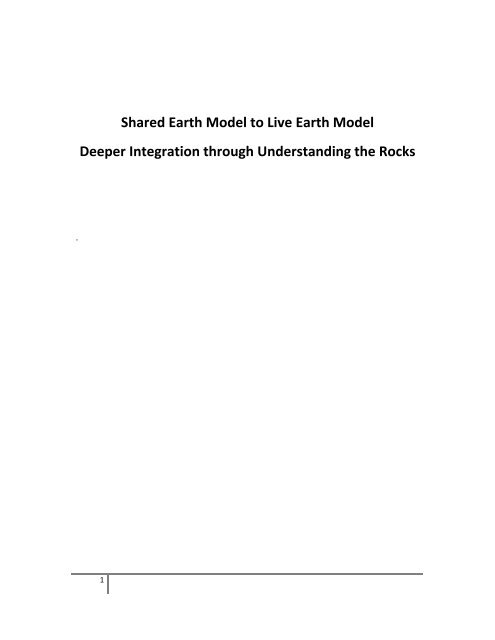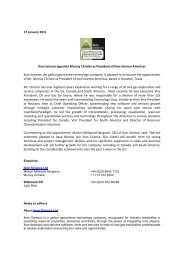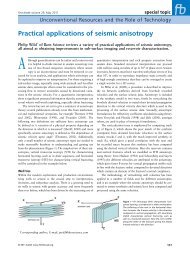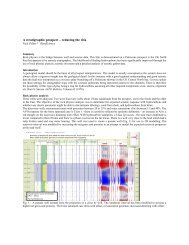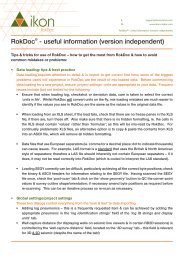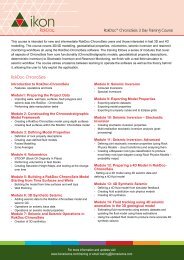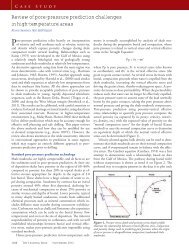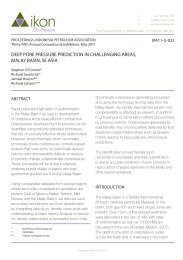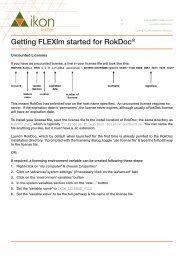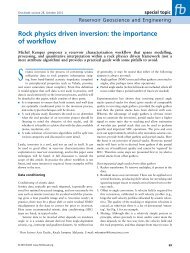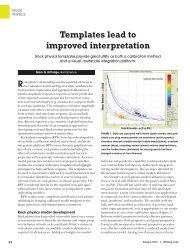Shared Earth Model to Live Earth Model Deeper ... - Net Brains
Shared Earth Model to Live Earth Model Deeper ... - Net Brains
Shared Earth Model to Live Earth Model Deeper ... - Net Brains
You also want an ePaper? Increase the reach of your titles
YUMPU automatically turns print PDFs into web optimized ePapers that Google loves.
<strong>Shared</strong> <strong>Earth</strong> <strong>Model</strong> <strong>to</strong> <strong>Live</strong> <strong>Earth</strong> <strong>Model</strong><br />
<strong>Deeper</strong> Integration through Understanding the Rocks<br />
.<br />
1
Let me take you back fifteen years, <strong>to</strong> the start of 1994. At that time, integration was a great<br />
buzz‐word in exploration and production. There were integrated multi‐disciplinary teams in<br />
the larger and more progressive oil companies and people were looking in<strong>to</strong> how software<br />
technology might be harnessed <strong>to</strong> push forward this integration.<br />
Prior <strong>to</strong> this time, for a decade or more, numerical modelling had been growing in scope and<br />
influence.<br />
Geophysicists had been making 1D and 2D models of seismic velocity and rock density and<br />
calculating synthetic seismic traces and sections in order <strong>to</strong> understand the geological<br />
significance of seismic reflections. Or the seismic response <strong>to</strong> geological features. This<br />
included as a subset AVO modelling which had led <strong>to</strong> the creation of a geophysical<br />
specialization in Lithology and Fluid Prediction (LFP).<br />
Reservoir simulation engineers had been making 3‐dimensional grid models of reservoirs<br />
and associated aquifers, with parameters representing the porosity and permeability of<br />
reservoir rocks and the fluid saturations and pressure within them. Their purpose was <strong>to</strong><br />
model the movement of fluids both in inter‐well spaces and in the future – or more<br />
specifically <strong>to</strong> predict well performance and oil/gas recovery.<br />
Fairly new at that time was a group of cellular 3D modelling packages with which geologists<br />
could represent the structural, stratigraphic and sedimentary features of a field. This was a<br />
great help in communicating geological concepts between subsurface team members.<br />
Each of these areas of modelling used its own specialised abstraction based on principles<br />
appropriate <strong>to</strong> its own science.<br />
2
An EU‐sponsored project called ARAMIS, running from 1992 <strong>to</strong> 1995, pioneered a new way<br />
of working by bringing <strong>to</strong>gether these three disciplines of subsurface modelling, like the<br />
Three Musketeers.<br />
The ARAMIS Project introduced the <strong>Shared</strong> <strong>Earth</strong> <strong>Model</strong><br />
All for One<br />
and<br />
One for All !<br />
Gawith, D.E. & Gutteridge, P.A. 1994 “Closing the Loop: Seismic<br />
Validation of Reservoir Simulation using a <strong>Shared</strong> <strong>Earth</strong> <strong>Model</strong>”<br />
Paper presented at EAPG Conference, Vienna 1994<br />
(Also in Petroleum Geoscience, Vol 2. 1996, pp 97‐103)<br />
The purpose of ARAMIS was <strong>to</strong> formalise a key principle underlying cross‐disciplinary<br />
integration: each discipline uses its own models against which <strong>to</strong> interpret subsurface data;<br />
and the more we can make these in<strong>to</strong> aspects of a common model, the more effective<br />
integration will be.<br />
The project set out <strong>to</strong> use technology <strong>to</strong> realise this principle and the result was the now<br />
well‐known <strong>Shared</strong> <strong>Earth</strong> <strong>Model</strong> concept in which the abstractions used computationally by<br />
each of the subsurface disciplines would be derived from a shared numerical description of<br />
the reservoir.<br />
A series of conference papers and publications helped <strong>to</strong> make the <strong>Shared</strong> <strong>Earth</strong> <strong>Model</strong> a<br />
familiar concept in most corners of the E&P world, and one aspect of its potential was<br />
demonstrated by the “Closing the Loop” paper, referenced here. This reported an<br />
experimental preview of the sort of integrated 4D modelling workflow which is only now<br />
available <strong>to</strong> general subsurface teams, for example through our RokDoc ChronoSeis<br />
software.<br />
3
During the last fifteen years a major part of the <strong>Shared</strong> <strong>Earth</strong> <strong>Model</strong> idea has become<br />
standard practice: pretty well every reservoir simulation model is now derived from a 3D<br />
geological model, with its porosity, permeability and <strong>Net</strong>/Gross properties dependent on<br />
the geology. It is still central <strong>to</strong> the way in which we discuss our methods – the<br />
EAGE/Europec 2007 London conference had a special session on <strong>Shared</strong> <strong>Earth</strong> <strong>Model</strong>s and<br />
last year’s conference in Rome had many sessions and papers on specific cases and general<br />
benefits of integrated modelling.<br />
However, the take‐up has not been universal and also not complete: basically we model<br />
structure, broad stratigraphy and depositional heterogeneity.<br />
On that point, a very important development, quite early on, was the application of<br />
geostatistical techniques in these 3D models <strong>to</strong> simulate the spatial variability of rock types<br />
and properties. These techniques had been taken from mining geoscience and adapted by<br />
reservoir engineers <strong>to</strong> model the heterogeneity which affects fluid flow in reservoirs; their<br />
inclusion in geological modelling was a clear sign of growing integration through technology.<br />
Further involvement of geophysics, in the sense of relating acoustic properties <strong>to</strong> geology<br />
and reservoir fluids, <strong>to</strong> make practical the approach of the “Closing the Loop” paper,<br />
effectively had <strong>to</strong> wait for Rock <strong>Model</strong>s <strong>to</strong> come along – <strong>to</strong> which we shall come in a<br />
moment.<br />
Before that, Events ...<br />
4
Let us remind ourselves of what has happened in our industry since 1994. The price of oil<br />
was about $15 <strong>to</strong> $20 and our project economics were conservatively based on$16. Then in<br />
1998/9 the price fell <strong>to</strong> $10 and the industry panicked. Exploration activity fell off and<br />
developments were postponed. Oil companies merged, were taken over and disappeared;<br />
thousands of experienced subsurface professionals were laid off and recruiting s<strong>to</strong>pped.<br />
Oil Price, US$ / Bbl (Money of the day)<br />
US Government data<br />
15 years ago<br />
Soon though, the price of oil recovered, and went on recovering. Exploration re‐started and<br />
developments were found <strong>to</strong> be economic again. More than that – now smaller fields could<br />
be profitable, and previously abandoned fields could be revived.<br />
When things had been improving for a few years, it became apparent that there had been a<br />
serious loss of experience and skills in the industry. Small developments take proportionally<br />
more subsurface effort than large ones. Oil companies did not have the experienced staff<br />
they would need <strong>to</strong> do the job in traditional ways; the consulting trade could make up some<br />
of the shortfall, but much of the accumulated knowledge and experience had moved away,<br />
in<strong>to</strong> universities and technology companies, or in<strong>to</strong> retirement.<br />
Now, despite the recent oil‐price bubble and its bursting (and the current financial<br />
difficulties), most people seem <strong>to</strong> agree that the economic growth of China and India will<br />
ensure that a general upward price trend continues, so we shall be able <strong>to</strong> make money<br />
from small developments and reserves‐enhancements. This means we shall have <strong>to</strong> learn<br />
how <strong>to</strong> handle a lot of relatively small projects without a lot of experienced subsurface<br />
professionals.<br />
This brings us back <strong>to</strong> our subject: integration.<br />
5
Technology can contribute by helping the subsurface disciplines <strong>to</strong> reinforce each other<br />
through a new phase of <strong>Shared</strong> <strong>Earth</strong> <strong>Model</strong>s, and by encapsulating the fruits of experience<br />
in the <strong>to</strong>ols that people use.<br />
What this means is that the need for integration has now moved <strong>to</strong> a deeper level<br />
concerning the nature of the rocks we are modelling in our shared earth models<br />
Geophysicists, Petrophysicists and Petroleum Engineers are all interested in rock properties,<br />
and these properties are dependent on the geology of the reservoir, but we are not doing<br />
enough <strong>to</strong> take advantage of the fact that these are properties of the same rocks.<br />
Put simply, we treat rock properties in models either as independent quantities (only the<br />
position in the model is common) or as being related by transforms; we do not use the<br />
interdependencies between properties and so fail <strong>to</strong> make the best use of the shared<br />
model. There are opportunities <strong>to</strong> synthesize a more accurate and less uncertain picture by<br />
the use of Rock <strong>Model</strong>s.<br />
6
A Rock <strong>Model</strong> is a set of equations and statistics capturing the relationships between<br />
physical properties for a given rock type or formation. They have been around for a long<br />
time, but in the background, as obscure rules for specialists.<br />
I believe we are about <strong>to</strong> see Rock <strong>Model</strong>s as central <strong>to</strong> a new phase of Integration, bringing<br />
<strong>Shared</strong> <strong>Earth</strong> <strong>Model</strong>s <strong>to</strong> life.<br />
In our RokDoc ChronoSeis software they are known as Rock Physics <strong>Model</strong>s. Here are two<br />
examples, from RokDoc work‐flows, of how empirical relationships between rock properties<br />
are translated in<strong>to</strong> rules governing the properties in a 3D reservoir model.<br />
7
In the first instance we have some well‐logs and we cross‐plot VP against Porosity, with<br />
colour showing Vshale. We are interested in a rule for describing the relationship between<br />
these properties for the sands in our target formation away from well control. We find a<br />
standard empirical function that overlays the sands<strong>to</strong>ne points on our plot, adjust its<br />
coefficients and bring it in<strong>to</strong> a Rock Physics <strong>Model</strong> for use in 3D.<br />
8
In the second instance, we are going <strong>to</strong> use a Gassmann function for fluid substitution in a<br />
4D model, and we know that well‐based rock properties are likely <strong>to</strong> come <strong>to</strong>gether in some<br />
un‐physical combinations, owing <strong>to</strong> poor log quality. This will, if left alone, produce<br />
nonsense in our seismic modelling. Using a cross‐plot of well data points and a standard<br />
empirical function, we can define an acceptable range of rock matrix stiffness for any value<br />
of porosity. This is brought in<strong>to</strong> the Rock Physics <strong>Model</strong> <strong>to</strong> provide constraints in 4D.<br />
Rock Physics <strong>Model</strong>s are also very helpful in probabilistic modelling. I’ll give you a simple<br />
illustration.<br />
9
Seismic impedances <strong>to</strong> pressure waves and shear waves (P‐wave and S‐wave impedance AI<br />
and SI) are important acoustic properties which determine the amplitude‐v‐offset (AVO)<br />
character of seismic reflections. We use them in seismic reservoir characterization.<br />
If we measure these quantities with well logs and cross‐plot them we get something like the<br />
plot at <strong>to</strong>p‐left – there is a statistical relationship between AI and SI for the same rocks.<br />
Traditionally we make estimates of AI and SI from seismic data either as independent<br />
properties, in which case the resulting values cross‐plot like the view at <strong>to</strong>p‐right – no<br />
apparent relationship – or with a fixed relationship between them. Better estimates of P‐<br />
wave and S‐wave impedance can be achieved through the use of Rock Physics <strong>Model</strong>s.<br />
By encapsulating the statistical relationship between AI and SI for major rock‐types in the<br />
geological model, we can ensure that joint inversion produces results in agreement with<br />
Nature, like the plot at lower‐left. The modelled AI and SI values are consistent with each<br />
other and the reservoir geology, making them more likely <strong>to</strong> be accurate.<br />
So how do Rock Physics <strong>Model</strong>s come in<strong>to</strong> our 3D and 4D work? Lots of different ways; I’ll<br />
describe two scenarios.<br />
10
In reservoir description, or characterisation, a Rock Physics <strong>Model</strong> for one formation may<br />
contain: a statistical function relating AI and SI, which is used <strong>to</strong> constrain joint inversion of<br />
seismic data; and a set of probability functions for rock types mapped in AI:SI space for<br />
Bayesian classification. This will give probabilistic estimates of rock‐type throughout the 3D<br />
model, based on a combination of acoustic properties which are forced <strong>to</strong> be consistent.<br />
11
In 4D seismic modelling, for planning or interpreting time‐lapse surveys, a Rock Physics<br />
<strong>Model</strong>, again for one formation, might contain a single integrated rock‐model function. This<br />
would encapsulate an experience‐based model of the acoustic properties of the formation<br />
and how they vary with fluid saturation and pressure changes.<br />
Alternatively the Rock Physics <strong>Model</strong> might contain a set of empirical functions for Vp, Vs<br />
and Density and a fluid substitution function, typically Gassmann, constrained by a Dry Rock<br />
<strong>Model</strong>.<br />
Normally our integrated reservoir model will contain a Rock Physics <strong>Model</strong> for each of its<br />
stratigraphic zones, and each one will contain a number of functions whose job is <strong>to</strong> keep<br />
the geology, reservoir properties and acoustic properties consistent.<br />
12
But the idea can be expanded beyond seismic geophysics. Here are some other areas where<br />
Rock <strong>Model</strong>s can tie <strong>to</strong>gether the different model parameters previously determined<br />
independently in each subsurface discipline.<br />
13
Pressure:<br />
Changing pressure in the reservoir affects pore volume in the reservoir model through the<br />
engineering parameter of rock compressibility. This is related <strong>to</strong> the degree of rock matrix<br />
stiffness, which is affected by changing effective stress, due <strong>to</strong> changing reservoir pressure.<br />
Rock matrix stiffness in turn affects the seismic modelling parameters Vp & Vs.<br />
We would like <strong>to</strong> make the response <strong>to</strong> pressure changes consistent between models.<br />
14
Permeability:<br />
Reservoir permeability and porosity are central <strong>to</strong> flow simulation; porosity and mineralogy<br />
(vshale) are key parameters in seismic modelling with fluid changes; vshale strongly affects<br />
permeability. Clearly these properties should be physically consistent in an integrated<br />
model.<br />
15
Pore fluids and Resistivity:<br />
In seismic reservoir characterization there is often an ambiguity between hydrocarbonbearing<br />
reservoir rocks and acoustically similar non‐reservoir rocks. Integrating EM<br />
techniques brings a chance <strong>to</strong> resolve this ambiguity, with Rock <strong>Model</strong>s governing the<br />
relationships between geology, pore fluids, resistivity and acoustic properties.<br />
16
Fractured Reservoirs:<br />
What we know about fractured reservoirs tends <strong>to</strong> be divided up in<strong>to</strong> quite separate areas<br />
of expertise:<br />
reservoir engineers use abstract models with parameters based on an ideal fractured rock;<br />
structural geologists know about stress tensors associated with tec<strong>to</strong>nic regimes (they and<br />
rock mechanics specialists can make realistic 3D models of fracture systems);<br />
geophysicists understand empirically the effects of fracturing on seismic velocities and<br />
velocity isotropy, but cannot model them very well.<br />
This is an area of great importance for the future, where integration through understanding<br />
the rocks should pay large dividends.<br />
17
Geometry: often the biggest source of uncertainty<br />
Even with 3D seismic data it is often difficult <strong>to</strong> delineate complicated fault systems. There is<br />
ambiguity between seismic reflection correlation (the stratigraphy of the model) and fault<br />
correlation (the structure of the model). One situation in which this can be important is<br />
where understanding the fault system is the key <strong>to</strong> locating depositional sweet‐spots in a<br />
reservoir formation (where the best NTG is found).<br />
This is where gravity gradiometry may come in. Once the principal faults have been located<br />
and a good geological model framework built, we should be able <strong>to</strong> optimize the model<br />
details by integrating sedimen<strong>to</strong>logy, structural geology, rock density and acoustic<br />
properties (seismic response). This will lead <strong>to</strong> modelling realistic flow units in more<br />
accurate reservoir models.<br />
What does all this mean?<br />
18
The central point here is that a consistent set of model properties is more likely <strong>to</strong> be<br />
accurate than an unconstrained set, and that the constraints of each subsurface discipline<br />
can and should inform the interpretation of data in other disciplines. Rock <strong>Model</strong>s provide<br />
the internal connections in a new generation of <strong>Shared</strong> <strong>Earth</strong> <strong>Model</strong>s, so that different<br />
model properties at the same position in the model are consistent. They are properties of<br />
the same piece of rock, not just representative values for that type of rock.<br />
Technology:<br />
I am not proposing a whole new generation of subsurface technology – oil companies and<br />
contrac<strong>to</strong>rs alike have invested heavily in working with existing <strong>to</strong>ols. No, the geological<br />
model may continue <strong>to</strong> live in your favourite geological modelling package; seismic<br />
interpretation belongs in an interpretation system, and reservoir simulation models are<br />
used in reservoir simula<strong>to</strong>rs. Integration – the new deeper integration that defines the new<br />
generation of <strong>Shared</strong> <strong>Earth</strong> <strong>Model</strong>s – can be mediated by rock‐physics‐aware software that<br />
connects between these familiar <strong>to</strong>ols.<br />
Better integration means supplementing established software <strong>to</strong>ols, not replacing them.<br />
Result:<br />
If our integrated reservoir model is alive – if it will only express physically sensible<br />
combinations of properties, then the observations and interpretations of different<br />
sciences/disciplines can be integrated <strong>to</strong> ever better effect. The model can bring in<strong>to</strong> a<br />
subsurface study the benefits of experience gained elsewhere: Efficiency; Accuracy;<br />
Precision.<br />
19
Final remarks<br />
We are moving from <strong>Shared</strong> <strong>Earth</strong> <strong>Model</strong>s <strong>to</strong> <strong>Live</strong> <strong>Earth</strong> <strong>Model</strong>s.<br />
There is a shortage of experienced cross‐disciplinary people in our industry.<br />
Subsurface Integration through rock models can bring the <strong>Shared</strong> <strong>Earth</strong> <strong>Model</strong> <strong>to</strong> life and<br />
multiply the strength of subsurface teams, helping <strong>to</strong> make the best use of scarce resources<br />
‐ which is what our industry needs in volatile times.<br />
It is the job of technology companies, like Ikon Science, <strong>to</strong> make this happen.<br />
DEG Jan 2009<br />
20


